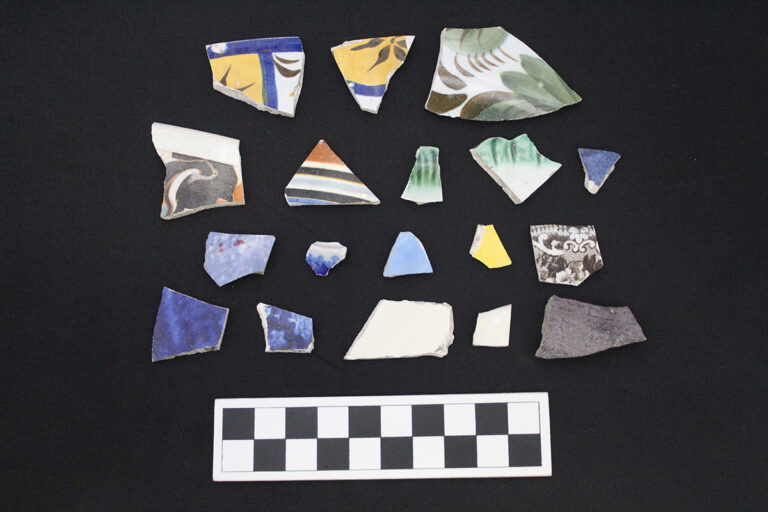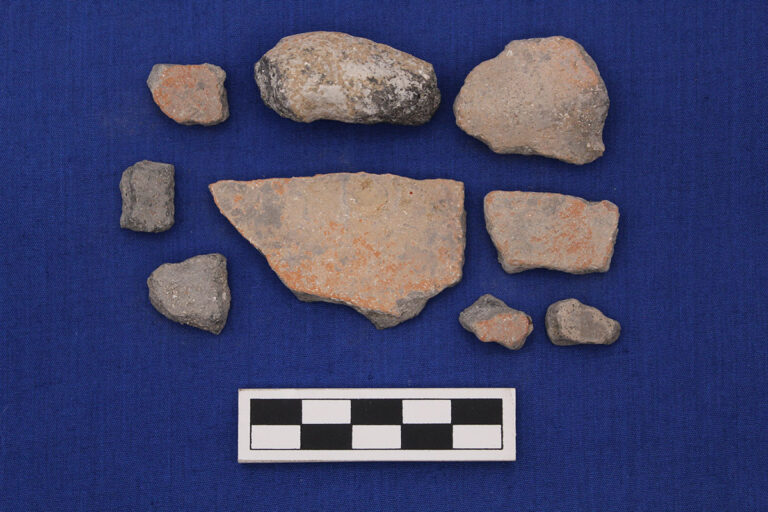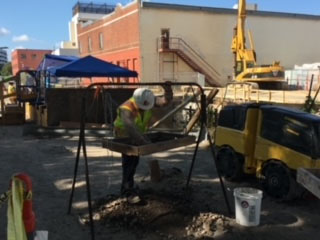The Buried Past is Never Lost
English
Español
-
Toxins that contaminate local waterways are produced by industry, construction, and transportation, particularly in the urban center. These portions of many streams, like San Pedro Creek, have also been confined in shallow concrete channels, resulting in low oxygen levels and high temperatures. Many native fish cannot survive in this unnatural environment; fish that can are called “tolerant.” Fish species that can tolerate semi-urban conditions are called “intermediate” fish. When biologists note the presence of intermediate fish in this section of the creek, they correlate their findings with water analysis data that typically show lower levels of chemical pollutants and more abundant in-stream vegetation than in the upper, more urban section of the creek. This length of San Pedro Creek may be considered a transitional zone between the channelized flood-control portion of the urban creek and the naturalized approach to its confluence with the San Antonio River.

Photo: Alan M. Cressler; Courtesy: United States Geological Survey. Longear Sunfish (Lepomis megalotis): This small to medium-sized fish is oval in shape and relatively flat. Its olive-gray top half and blue-green speckled sides give way to a yellow-orange belly. A white margin surrounds its dark, elongated gill. It is often found near in-stream cover including submerged and overhanging vegetation.

Photo: Totti; Courtesy: Wikimedia Commons (CC BY-SA 4.0). Photo: Karl Kurtz; Courtesy: Iowa Department of Natural Resources. Largemouth Bass (Micropterus salmoides): This most popular sport fish species in Texas is mostly dark green with lighter sides and a white or gray belly. It often has a dark lateral band stripe. A wide lower jaw juts forward distinctively, and the mouth extends back behind the eyes. This aggressive predator of insects, crawfish, frogs, and smaller fish needs well-oxygenated water and is a good indicator of water quality.

Photo: Karl Kurtz; Courtesy: Iowa Department of Natural Resources Central Stoneroller (Campostoma anomalum): This small fish appears silver to light brown with dark spotted sides and a lighter-colored belly. A bulbous snout juts forward above the mouth, whose flat, blade-like lower jaw is used to scrape algae and other plants from rocks and logs. It often swirls in schools while grazing along the bottom; however, it may be seen leaping from the water.
-
Las toxinas que contaminan las vías navegables locales son producidas por la industria, la construcción y el transporte, particularmente en el centro urbano. Estas porciones de muchos arroyos, como San Pedro Creek, también han sido confinadas en canales de concreto poco profundos, lo que resulta en bajos niveles de oxígeno y altas temperaturas. Muchos peces autóctonos no pueden sobrevivir en este entorno antinatural; los peces que pueden se llaman “tolerantes”. Las especies de peces que pueden tolerar las condiciones semiurbanas se denominan peces “intermedios”. Cuando los biólogos notan la presencia de peces intermedios en esta sección del arroyo, correlacionan sus hallazgos con los datos del análisis del agua, que generalmente muestran niveles más bajos de contaminantes químicos y una vegetación más abundante en el arroyo que en la sección superior más urbana. Esta parte del San Pedro Creek puede considerarse una zona de transición entre la porción canalizada del arroyo urbano (de control de inundaciones) y el tramo naturalizado que llega a su confluencia con el San Antonio River.

Photo: Alan M. Cressler; Courtesy: United States Geological Survey. Pez luna de orejas largas (Lepomis megalotis): Este pez de tamaño pequeño a mediano tiene forma ovalada y es relativamente plano. Su parte superior gris oliva y sus costados con manchas de color verde azulado dan paso a un vientre amarillo anaranjado. Un margen blanco rodea sus alargadas branquias oscuras. A menudo se encuentra cerca de la cubierta dentro del arroyo, incluyendo la vegetación sumergida y colgante.

Photo: Totti; Courtesy: Wikimedia Commons (CC BY-SA 4.0). Photo: Karl Kurtz; Courtesy: Iowa Department of Natural Resources. Perca atruchada (Micropterus salmoides): Esta especie de pez deportivo, la más popular en el estado de Texas, es principalmente de color verde oscuro con costados más claros y un vientre blanco o gris. Suele tener una franja lateral oscura. Una mandíbula inferior ancha sobresale distintivamente hacia adelante y la boca se extiende hacia atrás por detrás de los ojos. Este agresivo depredador de insectos, cangrejos de río, ranas y peces más pequeños necesita agua bien oxigenada y es un buen indicador de la calidad del agua.

Photo: Karl Kurtz; Courtesy: Iowa Department of Natural Resources Rodapiedras del centro (Campostoma anomalum): Este pez pequeño tiene una apariencia entre plateado y marrón claro, con los costados manchados de oscuro y el vientre de color más claro. Un hocico protuberante sobresale por encima de la boca, cuya mandíbula inferior plana, en forma de cuchilla, utiliza para raspar algas y otras plantas de rocas y troncos. A menudo se arremolina en cardúmenes mientras se alimenta en el fondo; sin embargo, se le puede ver saltando del agua.




